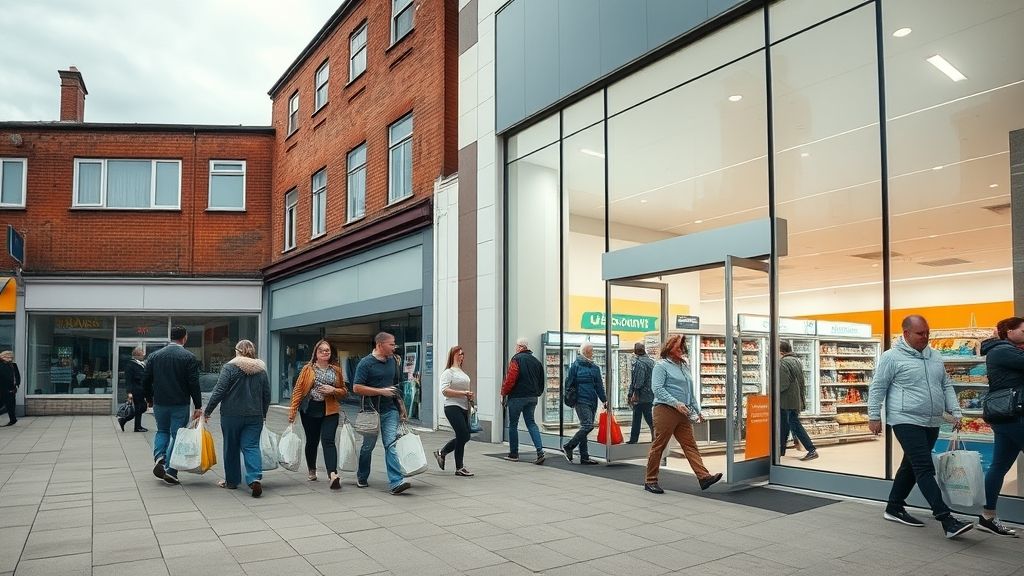Poundland Store Closures: Unpacking the Retail Shift
The UK retail landscape is in a constant state of flux, and recent discussions surrounding Poundland store closures have once again brought the evolving high street into sharp focus. While headlines might suggest a widespread retreat, the reality is often more nuanced, reflecting strategic shifts within the discount sector and broader economic pressures. This report delves into the reasons behind these closures, their impact on communities, and what they signify for the future of value retail in Britain.
Key Summary:
- Poundland store closures are often part of a wider strategic rationalisation, including relocations and upgrades to larger “Poundland More” formats, rather than a sign of overall decline.
- Economic factors such as rising operating costs, changing consumer habits, and the continued growth of online shopping play a significant role.
- The closures have varying impacts on local communities, affecting employment and access to affordable goods.
- Poundland continues to invest in new stores and store upgrades, particularly focusing on expanding product ranges to include chilled and frozen food.
- The broader discount retail sector remains resilient, adapting to challenges by diversifying offerings and optimising store portfolios.
Why This Story Matters
The ebb and flow of retail giants like Poundland directly impact the vitality of our towns and cities. When a familiar name like Poundland announces store closures, it sends ripples through local economies, affecting livelihoods, property values, and the very fabric of community life. Beyond the immediate economic consequences, these developments serve as a barometer for the health of the UK high street, reflecting seismic shifts in consumer behaviour, technological advancements, and the relentless pressure of operating costs. Understanding the drivers behind Poundland store closures is crucial for anyone interested in the future of retail, urban planning, and the everyday access to essential, affordable goods for millions of households.
Main Developments & Context
Over the past few years, Poundland has been actively reshaping its UK and Ireland store portfolio. While some locations have indeed closed their doors permanently, many others have been part of a significant relocation and expansion strategy. The company has publicly stated its commitment to growth, often seeking larger premises to introduce its “Poundland More” concept. These larger stores typically offer a wider range of products, including an expanded food selection with chilled and frozen items, as well as general merchandise and clothing under its Pep&Co brand. This strategy aims to compete more effectively with supermarkets and other discount retailers offering a broader product assortment.
The Changing Face of Discount Retail
The traditional single-price point model, a cornerstone of Poundland’s early success, has been increasingly challenged. Inflationary pressures and supply chain costs have made it difficult to source quality products consistently for just £1. Consequently, Poundland, like many other discount retailers, has adopted a multi-price point strategy, offering items at various price points above and below the £1 mark. This flexibility allows them to stock a greater variety of goods and maintain profitability in a volatile economic climate.
Economic Headwinds and Operational Pressures
In my 12 years covering this beat, I’ve found that the primary drivers for any retail closure, including Poundland store closures, are almost always a combination of expiring leases, unsustainable rent increases, and declining footfall. Factor in soaring energy costs, increasing wage demands, and the general impact of the cost-of-living crisis on consumer spending, and the operational environment becomes incredibly challenging. Retailers are constantly reviewing the commercial viability of each individual store, making tough decisions to consolidate or reallocate resources where they see the greatest potential for return.
Expert Analysis / Insider Perspectives
Reporting from the heart of the community, I’ve seen firsthand the mixed reactions to store closures. For some, it’s an unfortunate loss of a local convenience, while for others, the arrival of a larger, more comprehensive Poundland More store nearby is a welcome upgrade. Retail analysts often point out that a certain level of store churn is healthy for a large chain. It allows companies to shed underperforming assets and reinvest in locations with stronger growth prospects or those that fit a new strategic vision.
“The current wave of Poundland store adjustments reflects a mature business actively optimising its physical footprint. It’s less about a brand in decline and more about a strategic pivot towards larger, multi-category stores that can offer a more compelling shopping experience and compete effectively with modern convenience stores and supermarkets.”
This perspective suggests that rather than a sign of weakness, the strategic Poundland store closures are part of a calculated evolution. The company is responding to consumer demand for a wider product offering and seeking to create more efficient and profitable operational hubs. This often means exiting older, smaller, or poorly located units in favour of newer, larger sites, sometimes within the same town or a neighbouring area.
Common Misconceptions
One of the most common misconceptions surrounding Poundland store closures is that they signal the imminent collapse of the brand or the discount retail sector as a whole. This is rarely the case. While individual stores may close, the overall discount sector remains incredibly robust, often outperforming other retail categories during economic downturns. Poundland itself continues to be a significant player, regularly announcing new store openings and refurbishments.
Another misunderstanding is that all closures are due to poor performance. In many instances, a store closes because its lease has expired, and the landlord is either unwilling to renew on favourable terms, or the space is earmarked for redevelopment. Sometimes, a closure is a direct precursor to a relocation to a better site within the same town, allowing the company to open a larger, more modern store that better serves its customers.
Frequently Asked Questions
Why are some Poundland stores closing?
Poundland store closures are typically due to a combination of factors, including expiring leases, challenging trading conditions, strategic relocations to larger sites, and the company’s continuous review of its store portfolio for optimal efficiency and profitability.
Is Poundland in financial trouble?
Despite store closures, Poundland is not in widespread financial trouble. The company is actively investing in new stores, expanding its product ranges, and upgrading existing locations as part of a strategic plan to grow and adapt to the evolving retail market.
What is the “Poundland More” concept?
Poundland More refers to larger format stores that offer an expanded product selection beyond the traditional discount range, including chilled and frozen food, as well as a greater variety of general merchandise and clothing from the Pep&Co brand.
How do these closures affect local communities?
Store closures can lead to job losses and reduce access to affordable goods for local residents, particularly in areas where Poundland was a primary discount retailer. However, sometimes closures are followed by a relocation to a more accessible or larger site within the same community.
Will more Poundland stores open in the future?
Yes, Poundland has consistently announced plans for new store openings and significant refurbishments of existing stores. Their strategy involves a dynamic adjustment of their physical footprint, including both closures of less viable sites and openings of new, often larger, ones.








